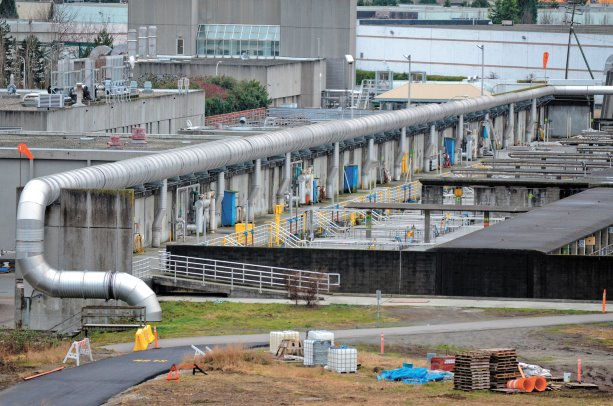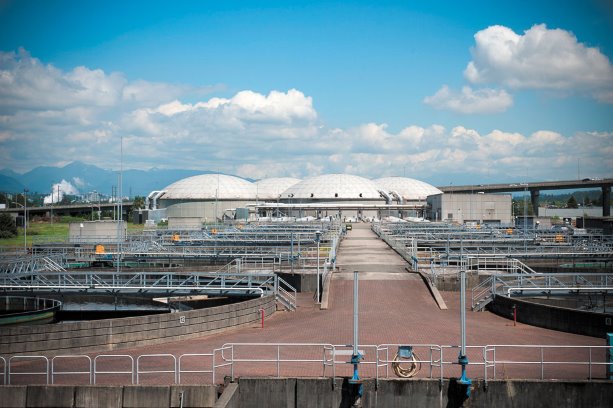A proposal by Metro Vancouver regional district to build a $9-million pilot project that would turn residual sewage sludge into a bio-crude could become one of three facilities in the world pushing forward a new technology that can replace anaerobic digesters at wastewater treatment plants throughout Canada.
"This is a pilot project that uses the hydrothermal process (HTP) which utilizes high pressure and high temperature," said Paul Kadota, a program manager for utility research and innovation for Metro Vancouver’s wastewater services, adding it utilizes temperatures up to 350 C and 200 bar (almost 3,000 pounds per square inch) which are applied to a wet source of organic material.
"What it does within one hour to the organic carbon is the same as Mother Nature does in a million years."
The process being proposed to convert municipal waste sludge was developed by the Pacific Northwest National Laboratory, part of the U.S. Department of Energy, which looked at a variety of feedstocks such as food sludge, sewage sludge, manure and pulp industry residuals that could be used to turn into bio-fuels.
Kadota said sewage sludge is seen as good feedstock as it has gone through initial screening and many contaminates such as plastics have been removed.
The first HTP plant was built in 2015 at Reliance Energy’s largest refinery in India (utilizing algae as bio mass). The equipment was developed by Genifuel Corporation.
The U.S. Department of Energy is currently building the second plant for its own use for further experimentation with feedstocks. Metro Vancouver would be the first wastewater treatment entity in North America to host the technology at its Annacis Island Wastewater Treatment Plant.
"There is interest in this technology and we are hopeful to get the needed funding and be the first," said Kadota, as Metro Vancouver allocated $4 million for the project.
Sewage sludge is made up of solid or semi-liquid material that remains and settles out after the primary treatment process and this material passes to secondary treatment facilities.
Currently these solids are being treated in anaerobic digesters where bacteria in an oxygen-deprived atmosphere further breaks down material creating methane gas, which is captured and used.
The remaining solids, within the Metro Vancouver system, are then used for mine site reclamation.
The problem with anaerobic digesters, said Kadota, is that they are slow and not completely efficient.
They are expensive to build, require a massive footprint, require large amounts of concrete to build the holding tanks and the residency time for materials, depending on feedstock, is 15 to 30 days.
Also, the most efficient anaerobic digesters, depending upon the feedstock, will only reduce 50 to 60 per cent of bio-waste.
The HTP plant has a smaller footprint and can handle the material more efficiently.
The HTP utilizes virtually 100 per cent of the material in a two-step process. The first is hydrothermal liquefaction (HTL) which converts up to 80 per cent of the carbon-based waste into bio-crude that can be refined into products such as bio-diesel or can be used as bunker fuel. The process takes approximately an hour.
The remaining material goes through a second step, a catalytic hydrothermal gasification system that essentially leaves little residual material. The system streams out components such as phosphorus, ammonia and other trace minerals.
"Metro Vancouver has realized it needs to do something more," said Kadota, as populations are increasing and increased volumes of waste are being generated.
Kadota has been involved over the past year with the U.S. Department of Energy assessing the feasibility of implementing its new technology.
Metro Vancouver is attempting to move towards a policy in wastewater treatment of zero odour, energy consumption and waste, Kadota said, and the technology has the potential to achieve those targets.
Metro Vancouver’s Annacis Island wastewater treatment plant currently utilizes four anaerobic digesters which produce methane gas and converts it to produce 100 per cent of the plant’s heating requirements and 50 per cent of its electricity.
Metro Vancouver is completing its first part of a Stage 5 Expansion at the Annacis Island facility to accommodate regional growth with the installation of 5,000 stone columns to enhance seismic protection which is now 95 per cent complete.
Earlier this year, Graham and AECON, NAC Constructors Ltd. and JJM Construction Ltd., and Peter Kiewit Infrastructure Co. were shortlisted in a prequalification process.
These three proponents are invited to submit proposals in fall 2016 for Phase 1 construction. Under this contract, scheduled to start in early 2017, new process units will be constructed to increase capacity of the primary sedimentation and secondary treatment processes. Odour control facilities at the treatment plant will also be expanded.
Kadota said it is possible to "gravy-train" the new technology onto existing anaerobic digesters as a retrofit but it would be more efficient to install new units in at new construction sites such as the North Shore’s Lions Gate secondary treatment facility.
The request for proposals for the Lions Gate project, a public-private partnership that is a design-build-finance initiative, started in spring with the contract award expected to be early 2017.
With $4 million in hand, Kadota said he is currently applying to both provincial and federal governments for additional funding for the projects.
"We are hoping to get a design in 2017 and possibly the building erected as well," he said, adding that equipment fabrication and start-up could occur in 2018. The pilot plant will only take 1/50th of the volume of sludge that Annacis Island treatment facility produces. He said the proposal would look at how efficient the HTP pilot plant performs and if deemed successful, the next step would be to move to a larger plant but utilizing a scale of 10 fold to ensure that all associated problems are dealt with.
"One of the ideas is that we do this once more or twice more and then go to a full-scale plant," he said.
The HTP’s bio-crude would need to be refined to produce products such as bio-diesel, which is a growth market in the U.S. and overseas in Singapore.
"We are currently looking at a refiner partner for the pilot project. This pilot will only produce weekly about 50 to 60 barrels — that is really a drop in the bucket for large refineries," he said as initial inquiries to larger oil refineries has indicated there is no economy for them handling such a small volume. "You would have thought they would have wanted to do it as a green partnering opportunity."
While the U.S. Department of Energy holds patents for the processes, other international researchers have been involved in the technology. South Korean research teams conducting studies in 2012 have also concluded that using sewage sludge is a viable source for bio-diesel and as a feedstock can come in at a lower price than conventional feedstock such as soybeans and algae.

1/2
Metro Vancouver regional district is proposing to pilot a project at its Annacis Island Wastewater Treatment Plant that would take residual sewage sludge and turn it into a bio-crude, becoming one of three facilities in the world pushing forward a new technology that can replace anaerobic digesters at wastewater treatment plants throughout Canada
Photo: Jeff Hitchcock/FLICKR











Recent Comments
comments for this post are closed